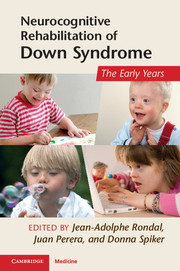Book contents
- Frontmatter
- Contents
- List of contributors
- Preface
- Acknowledgments
- Section 1 Definition, history, methodology, and assessment
- Section 2 Genetics, brain, and animal models
- Section 3 Pharmacological and medical management and treatment
- 7 Pharmacotherapy for children with Down syndrome
- 8 Early medical caretaking and follow-up
- 9 Evaluation and management of cardiovascular diseases in Down syndrome
- Section 4 Early development and intervention
- Section 5 Therapeutic perspectives
- Conclusions
- Index
- References
7 - Pharmacotherapy for children with Down syndrome
Published online by Cambridge University Press: 05 July 2011
- Frontmatter
- Contents
- List of contributors
- Preface
- Acknowledgments
- Section 1 Definition, history, methodology, and assessment
- Section 2 Genetics, brain, and animal models
- Section 3 Pharmacological and medical management and treatment
- 7 Pharmacotherapy for children with Down syndrome
- 8 Early medical caretaking and follow-up
- 9 Evaluation and management of cardiovascular diseases in Down syndrome
- Section 4 Early development and intervention
- Section 5 Therapeutic perspectives
- Conclusions
- Index
- References
Summary
Introduction
The field of cognitive pharmacology for children with intellectual disability (ID) does not actually exist. As defined by the level of support for clinical trials, or FDA-sanctioned indications, most physicians would be hard pressed to name a single medication used for such a purpose in children. There are few clinical paradigms and little informed consensus about how to navigate these uncharted waters. Despite our advance into the era of genome-based medicine, the mechanisms that support cognition and its neurobiological organization in the brain are still very much in a discovery phase. New appreciation for the biochemical and physiological mechanisms of synaptic dysfunction in neurogenetic disorders holds promise for developing novel therapeutic approaches to ID (Johnston, 2006). Recent advancements using animal models have led to clinical trials for fragile-X syndrome, which is leading the effort to develop therapies for ID based on mechanistic principles (Hagerman et al., 2009).
While scientific investigators may be well equipped to grapple with questions of how to achieve a measureable degree of cognitive enhancement in children with Down syndrome (DS) and ID, they are perhaps less inclined to consider their own motives for doing so. Concerns about biologically informed treatments for persons with DS/ID have a long and colored history, which should not be ignored (Rynders, 1987). Hence, as the scientific pursuit of enhancing cognitive function and related outcomes continues, it remains necessary for clinicians and families to contemplate: why do this; for what purpose, and under what circumstances?
- Type
- Chapter
- Information
- Neurocognitive Rehabilitation of Down SyndromeEarly Years, pp. 96 - 116Publisher: Cambridge University PressPrint publication year: 2011
References
- 2
- Cited by



